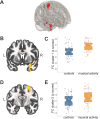Short communication: Lifetime musical activity and resting-state functional connectivity in cognitive networks
- PMID: 38696395
- PMCID: PMC11065262
- DOI: 10.1371/journal.pone.0299939
Short communication: Lifetime musical activity and resting-state functional connectivity in cognitive networks
Abstract
Background: Participation in multimodal leisure activities, such as playing a musical instrument, may be protective against brain aging and dementia in older adults (OA). Potential neuroprotective correlates underlying musical activity remain unclear.
Objective: This cross-sectional study investigated the association between lifetime musical activity and resting-state functional connectivity (RSFC) in three higher-order brain networks: the Default Mode, Fronto-Parietal, and Salience networks.
Methods: We assessed 130 cognitively unimpaired participants (≥ 60 years) from the baseline cohort of the DZNE-Longitudinal Cognitive Impairment and Dementia Study (DELCODE) study. Lifetime musical activity was operationalized by the self-reported participation in musical instrument playing across early, middle, and late life stages using the Lifetime of Experiences Questionnaire (LEQ). Participants who reported musical activity during all life stages (n = 65) were compared to controls who were matched on demographic and reserve characteristics (including education, intelligence, socioeconomic status, self-reported physical activity, age, and sex) and never played a musical instrument (n = 65) in local (seed-to-voxel) and global (within-network and between-network) RSFC patterns using pre-specified network seeds.
Results: Older participants with lifetime musical activity showed significantly higher local RSFC between the medial prefrontal cortex (Default Mode Network seed) and temporal as well as frontal regions, namely the right temporal pole and the right precentral gyrus extending into the superior frontal gyrus, compared to matched controls. There were no significant group differences in global RSFC within or between the three networks.
Conclusion: We show that playing a musical instrument during life relates to higher RSFC of the medial prefrontal cortex with distant brain regions involved in higher-order cognitive and motor processes. Preserved or enhanced functional connectivity could potentially contribute to better brain health and resilience in OA with a history in musical activity.
Trial registration: German Clinical Trials Register (DRKS00007966, 04/05/2015).
Copyright: © 2024 Liebscher et al. This is an open access article distributed under the terms of the Creative Commons Attribution License, which permits unrestricted use, distribution, and reproduction in any medium, provided the original author and source are credited.
Conflict of interest statement
O. Peters received fees for consultation from Abbvie, Biogen, Eisai, Griffols, MSD Roche, and Schwabe. J. Priller received fees for consultation, lectures, and patents from Neurimmune, Axon, Desitin, and Epomedics. J. Wiltfang is an advisory board member of Abbott, Biogen, Boehringer Ingelheim, Immunogenetics, Lilly, MSD Sharp & Dohme, and Roche Pharma and received honoraria for lectures from Actelion, Amgen, Beeijing Yibai Science and Technology Ltd., Janssen Cilag, Med Update GmbH, Pfizer, Roche Pharma and holds the following patents: PCT/EP 2011 001724 and PCT/EP 2015 052945. J. Wiltfang is supported by an Ilidio Pinho professorship, iBiMED (UIDB/04501/2020) at the University of Aveiro, Portugal. E. Düzel received fees for consultation from Roche, Biogen, RoxHealth and holds shares in neotiv. F. Jessen received fees for consultation from Eli Lilly, Novartis, Roche, BioGene, MSD, Piramal, Janssen, and Lundbeck. The remaining authors report no conflicts of interest. This does not alter our adherence to PLOS ONE policies on sharing data and materials.
Figures

References
-
- Verghese J, Lipton RB, Katz MJ, Hall CB, Derby CA, Kuslansky G, et al.. Leisure activities and the risk of dementia in the elderly. The New England journal of medicine. 2003;348(25):2508–16. - PubMed
-
- Mansens D, Deeg DJH, Comijs HC. The association between singing and/or playing a musical instrument and cognitive functions in older adults. Aging Ment Health. 2018;22(8):964–71. - PubMed
Publication types
MeSH terms
LinkOut - more resources
Full Text Sources
Medical

